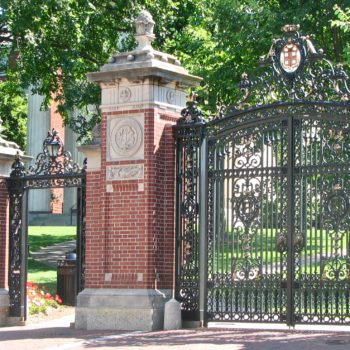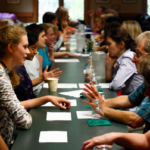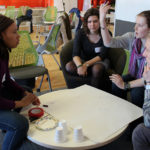This article was originally published in Inside Higher Ed.
When sociology professor Tamara Kay saw statistics being misused in a local debate over right to work laws, she felt it was her public duty to weigh in. In op-eds, media interviews, and testimony before the New Mexico state legislature, Kay countered the “kindergarten math” being employed to inaccurately suggest a connection between right to work laws and lower unemployment rates.
Kay struck on a simple yet effective analogy to explain the difference between correlation and causation: discovering that regions with more storks also have higher birth rates doesn’t mean that storks deliver babies. Thanks to Kay, local policymakers and journalists were armed with a better understanding of the research on right to work laws. The legislation ultimately died in committee.
This kind of public engagement serves as a powerful rejoinder to critics who question the relevance of the academy in today’s world. With universities under increasing pressure from funders, politicians, and the public to demonstrate the value of their work, some are taking a more active role in driving research impact. They are investing in public engagement to showcase the importance of their scholarship and reach the practitioners, policymakers, business and nonprofit leaders, journalists, activists, and citizens who can help turn their research into action.
In an era of instant free communication, it has become harder to defend having academic knowledge doled out exclusively within the confines of the academy. Engaged scholars like Kay are expanding beyond courses, lectures, journals, and conferences that are only available to a small number of students and scholars with relevant expertise and institutional access. They are harnessing new channels to disseminate academic knowledge by writing, blogging, tweeting, podcasting, creating online courses, giving public talks, and developing videos and infographics about their research.
If the internet is the carrot drawing the academy to new opportunities for sharing knowledge, the stick is a series of economic, political, and cultural forces to which they are struggling to adapt. In the face of declining public funding for higher education and rising tuition costs and student debt, universities face pressure to prove their worth to funders, policymakers, students, and alumni. The emphasis on rankings – of institutions, journals, and individual scholars – has contributed to a sense that academia is at risk of having its value reduced to numbers.
These changes are connected to an increasingly market-oriented vision of higher education that views the university as a business and a key piece of infrastructure within the knowledge economy. The intense focus in recent years on STEM education and research is emblematic of this conception of the university as a source of workers, technology, and innovative ideas to fuel economic progress. This economic mission has been appended, sometimes contentiously, to the university’s more traditional goals of cultivating educated citizens and wide-ranging knowledge in support of an open, democratic society.
At an individual level, similar forces are impacting scholars. In the increasingly precarious academic job market, tenured professor positions – and the security and academic freedom they offer – are rare. In response, young academics are plotting career courses that do not revolve solely around teaching and research, but instead incorporate writing, consulting, public speaking, and stints in other sectors. Having been raised with a hunger for meaningful and impactful work, they are increasingly questioning the idea that a scholar who writes for the public, rather than her peers, is a sell-out.
As these forces shift the ground beneath the academy’s feet, some universities and research centers are carving their own path forward. They are taking seriously the importance of impact and the value of having academic work reach lay audiences. But rather than having funders, government, and industry dictate the form and focus of their research, the savviest scholars and institutions are proactively engaging with the broader world and exploring new formats and channels for disseminating their own narratives about their work.
Marcia Chatelain, an Associate Professor of History and African American Studies at Georgetown University, is a great example of this trend. She’s active on Twitter, a frequent guest on television and radio, a contributor to mainstream publications like The New York Times, and a co-host of two podcasts. In 2014, she created the Twitter hashtag #FergusonSyllabus to crowdsource resources for educators on race and policing in the wake of the Michael Brown shooting. She sees these activities as smart career moves that are also personally fulfilling ways to “democratize knowledge.”
As standouts like Chatelain blaze the trail for engaged scholarship, many academics want to follow suit but can’t do it on their own. In my years of helping scholars share their research with new audiences, I’ve found that most are eager for their work to have a wider impact, but uncertain about how to proceed. Academia doesn’t prepare or incentivize them to engage with the public. They already wear many hats, as researchers, teachers, mentors, and administrators, and adding the role of external communicator to the list can seem daunting.
If we want engaged scholarship to be the norm rather than an optional side gig for a determined few, universities need to develop structures, incentives, training, and support to make communication and research impact core components of being an academic. In the UK, institutions are increasingly providing “knowledge brokers” that connect their scholars with the outside world. The organization I co-founded, Footnote, helps the academic community amplify the impact of their research by translating it into accessible, engaging formats and sharing it with mainstream audiences. We’re part of a growing ecosystem that supports research communication, from online platforms like Futurity to training programs such as those offered by the American Association for the Advancement of Science.
While expanding our definition of what it means to be a scholar is a long-term project, it can have immediate benefits for researchers and institutions. Prioritizing and investing in engaged scholarship can help universities enhance their reputations, differentiate themselves from other institutions, inspire and engage students and faculty, secure support from funders and policymakers, invigorate alumni investment, and better prepare students to apply their knowledge after graduation.
The university’s mission has always been to create and spread knowledge. What’s changing is the conception of how far and wide that knowledge should be shared and what academia’s role is in the process. “We’re in the middle of a sea change, maybe even a generational change,” says Anthony Leiserowitz, Director of the Yale Program on Climate Change Communication, a group that studies the most effective ways to share climate science with the public. “The [academic] community came to the realization that scientists can’t just sit on the sidelines at home and pray that people understand our work.”
We’re also in the midst of an “epistemic crisis,” in which our increasingly information-saturated society is rife with confusion about “fake news” and who to trust. Academics have the credibility and expertise to cut through the noise. By taking seriously their role in knowledge dissemination, universities can increase the impact of their research and redefine their role as society’s guardians of knowledge. Engaged scholarship enables the academy to navigate the tides it faces on its own terms while staying true to its core mission and identity.





